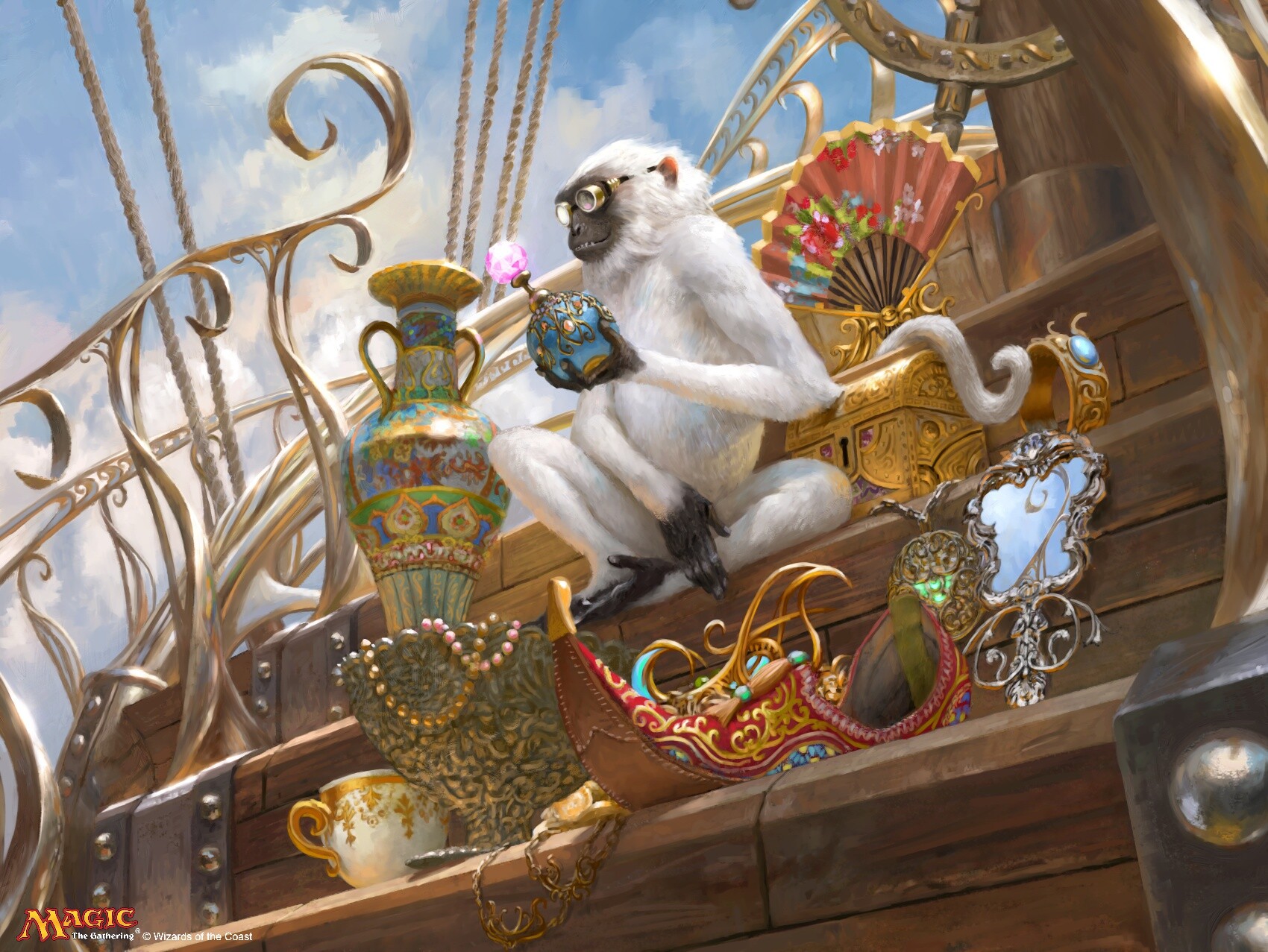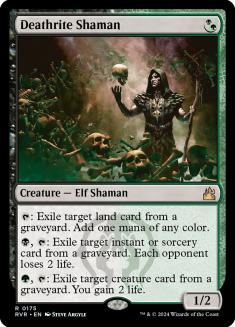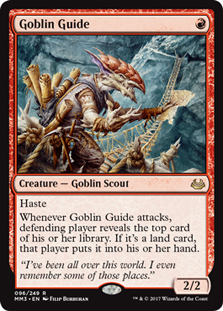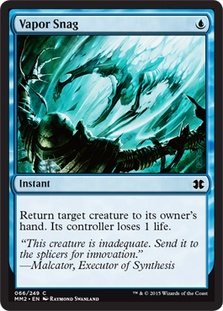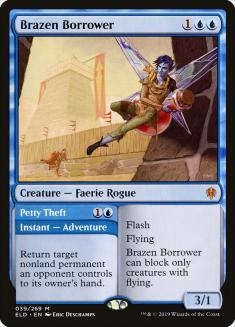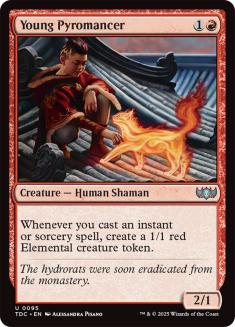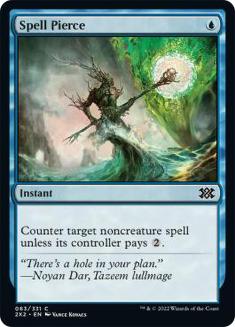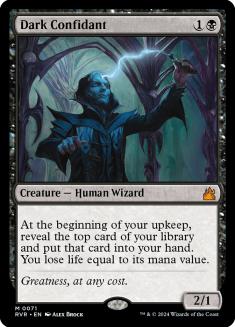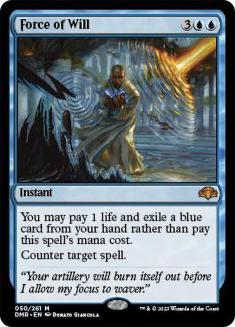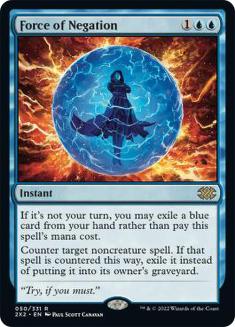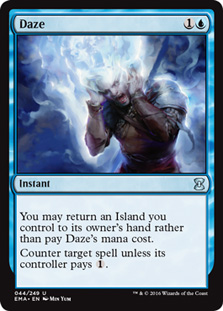On raw power level alone, Modern Horizons 2 looks to be one of the strongest sets of all time. There are so many build-around cards, versatile answers, powerful threats, and enough nostalgia to reach back in time and make 16-year old me giggle. I’m so excited and happy but also scared? It’s weird because I’m starting to think Modern Horizons 2 might completely reshape Modern, and I don’t think that’s necessarily a bad thing.
At the end of last week, Amy the Amazonian previewed a cool card in a really fun way. If you’re unfamiliar with Amy, she regularly draws Magic cards on her channel. This was the preview card she got from WotC.
During most preview seasons, I find a few cards that I think could be “best card in the set.” On occasion, I find a card that I think could reshape an entire format. Dreadhorde Arcanist was one of those cards. I shot-called it changing Legacy before it was available to preorder. My hit rate on writing articles about cards that eventually get banned is very high.
Ragavan, Nimble Pilferer is the best red one-drop ever printed.
I haven’t proxied it up. I haven’t played a game with it. I didn’t work for WotC and test it. I’m just a guy who looks at and thinks about Magic every single day, and has done so for the past twenty some odd years. I’ve played with Jackal Pup in Extended. Isamaru, Hound of Konda was a groomsman in my wedding. Grim Lavamancer picks me up from the airport. Goblin Guide and I aren’t on speaking terms (but I blame that mostly on their relationship with Boros Charm). What I’m trying to say is that I’ve played an aggressive deck or two in my tenure, and Ragavan has me salivating.
The closest comparison I have to Ragavan is Deathrite Shaman, a creature so powerful and compact that it’s banned in both Modern and Legacy. Deathrite Shaman being able to produce mana without entering the combat zone is obviously a big difference, but you don’t need to be as good as Deathrite Shaman to be completely busted.
Needing to attack and connect to generate the extra mana is seen as a downside by a lot of people that I’ve talked to. Jumping through some hoops should be necessary to facilitate such a landslide play pattern. Instead, I’m choosing to think of Ragavan in a different way: while you get to attack with an efficient creature, you’re rewarded for clearing blockers and playing normal Magic. The disconnect here is that people aren’t understanding the strength of the ability when you put it on a one-mana creature. On top of that, it’s a one-mana creature with two power in a color that puts an emphasis on aggression. There’s a reason Jackal Pup had such a huge downside. The utility that burn spells offer an aggro deck are unrivaled. Being able to point your creature removal at the opponent’s face is so strong that red shouldn’t have access to creatures this efficient without some drawback.
Goblin Guide is a perfect example of efficiency with a cost. It’s one of the best red creatures ever printed, but Goblin Guide comes with a drawback because there’s an understanding that Lightning Bolt is king. For my entire career, I’ve tried pairing creatures from other colors with Lightning Bolt specifically because the red creatures had a drawback or were somewhat weak in comparison to Tarmogoyf or Snapcaster Mage.
Goblin Guide provides you with a very specific direction: end the game before the downside actually matters. Like Jackal Pup before it, the damage output offered for such a small investment of mana comes with a price. Ragavan is almost the opposite, playing more like a blue or green creature with a red casting cost. Hilariously enough, when it comes to casting Lava Spike, I would much rather have Goblin Guide than Ragavan. However, if I’m curving into bigger stuff like Chandra, Torch of Defiance or Glorybringer, Ragavan starts to look a lot more appealing. If Ragavan were in Pioneer, it would likely make Chonky Red into a Tier 1 archetype, and may open the door for something similar in Modern.
Someone asked me on Twitter if I thought Ragavan was better than Goblin Guide or Monastery Swiftspear in Burn. The short answer is no. Those creatures are almost perfect for Burn and I don’t think they’ll be replaced anytime soon. They are pinnacles of damage output for red and that’s not what Ragavan is about. The extra mana from Ragavan doesn’t do much in a deck full of cheap spells that don’t replace themselves, and the extra cards from the opponent won’t likely do much to further your plan of dealing twenty damage. However, I think Ragavan could lead to so much more. Red as a core identity doesn’t have to be Lava Spike.
Modern Problems Require Modern Answers
Ragavan is not exactly operating on the same wavelength as Delver of Secrets. One of the core elements that makes Delver great is evasion and massive damage swings for just a single mana. Like Deathrite Shaman before it, Ragavan looks to fill the role of auxiliary one-drop that does something different, and offers alternating play patterns that make it difficult for your opponent to cover all bases.
When playing counterspells like Remand or Counterspell proper, creatures like Monastery Swiftspear are significantly worse than if you’re getting more aggressive. Delver decks excel when they can stick a threat and spend the rest of the time and energy dealing with the opponent’s creatures or countering their spells. Creatures that force you to play your spells at sorcery-speed aren’t conducive to the threat + protect mentality that Delver of Secrets incentivizes. Ragavan, while acting a little differently in its play pattern, offers similar rewards to interacting with the opponent on your own terms.
Creatures (14)
Lands (21)
Spells (25)
- 4 Lightning Bolt
- 3 Counterspell
- 4 Serum Visions
- 3 Opt
- 2 Spell Pierce
- 2 Vapor Snag
- 3 Force of Negation
- 4 Archmage's Charm
Sideboard

This version of Delver likes to go a little bigger than the Death’s Shadow versions, playing powerful card advantage and interaction like Archmage’s Charm and Snapcaster Mage. Those spells make the Treasure creation under Ragavan that much stronger, offering you sequences that would otherwise be impossible.
When you’re playing a card like Ragavan that rewards you so heavily for getting in damage, any type of creature removal is valuable. Vapor Snag has often been paired with Delver of Secrets as a temporary answer to creatures that don’t die to Lightning Bolt. The extra damage can really add up in some weird spots, and protecting your own creature has a lot of potential utility. Snapcaster Mage is a high priority target for your own Vapor Snags, as it can reset it in response to removal and let you double up on Counterspell or Lightning Bolt.
Brazen Borrower is a great way to utilize the extra mana from Ragavan, both in terms of bouncing the opposing creature and having a larger threat that costs more mana later on. There’s a good chance Brazen Borrower goes up to the full four as a bridge threat to put emphasis on the Treasure tokens and bounce effect.
As a midrange creature, Young Pyromancer benefits greatly from having extra mana. If we go more midrange and away from being overly aggressive, Ragavan could be our only one-drop and help fuel a full set of Young Pyromancer. The play patterns that involve killing the opposing creature then casting a two-drop off the Treasure on the second turn are just outrageous. More threats like Young Pyromancer also add value to Force of Negation, as protecting a more robust threat rewards you as the game progresses.
These two counters offer us potent interaction for a relatively small investment. We’re a little more mana intensive than traditional Delver decks on purpose in the hopes that the Ragavan mana will be put to better use. Remember what I said about Ragavan being mediocre in Burn? The complete opposite is true here. Because so many cards in your deck replace themselves or have variable casting costs, the Treasure tokens are going to be lit.
Counterspell, in particular, is a choice I made after considering the sacrifice of a more traditional mana base. When you realize Counterspell is actually pretty good in a Delver deck, things start to come together. Having all your lands tap for blue makes it easier to justify Archmage’s Charm as well. The versatility Archmage’s Charm offers is so absurd. While it gets cast as Divination a good portion of the time, stealing a Death’s Shadow or Monastery Swiftspear can completely change the texture of the game. Against control or combo, having that extra piece of interaction is huge. Archmage’s Charm is one of my favorite cards printed in the last few years, and I’m very happy with the versatility it offers a deck like Izzet Delver.
This is a card I haven’t played much lately. It’s a little weak to creature-heavy strategies, but protecting your threats when they’re as powerful as Ragavan is ludicrous. I also expect a lot of weird stuff to start cropping up with Modern Horizons 2, which makes cheap counters like Spell Pierce a bit better than they would normally be.
Delver decks often thrive in combo or spell-heavy formats, and are weaker against opponents who play a lot of creatures. When Spell Pierce is good, that usually means Delver is owning. The same goes for cards like Remand, but I would much prefer to play Counterspell if it doesn’t hurt our mana base too much. Thanks to Spirebluff Canal, playing Counterspell while maintaining a high red count for the first turn Ragavan is not super painful.
What Legacy Will Ragavan Leave Behind?
One thing I’d like to note is that the cards from Modern Horizons 2 could have a significant impact on Legacy. Ragavan, in particular, seems like it could be a fine addition to the best archetype in the format: Delver. People thought banning Oko, Thief of Crowns and Dreadhorde Arcanist would hinder Delver’s dominance, but it seems like the best thing to be doing is casting small creatures and using cheap interaction to protect those creatures.
Mana is a specific bottleneck in Legacy thanks to Wasteland and Daze. That’s one of the reasons why Deathrite Shaman was so powerful. A cheap creature that generates mana and has a lot of utility otherwise is desirable because of how well it interacts with Wasteland, and how it can fight against Daze. On the play, Deathrite Shaman into Wasteland plus a two-drop like Dark Confidant or Young Pyromancer was exceptional.
Ragavan should be able to provide similar play patterns to Deathrite Shaman. If that sentence doesn’t scare you, I don’t know what will. While Deathrite Shaman didn’t require many hoops to generate mana, Ragavan offers you a lot of steamroll play patterns without and applies pressure to combo decks. In my experience, Deathrite Shaman was pretty mediocre against control and combo because it didn’t offer a lot of damage for the investment, and ramping into bigger spells or more spells wasn’t exactly a big deal. Ragavan does the same thing against basically all control and combo decks while attacking for two.
Legacy is also the place where the “reveal a card and you can cast it” ability will shine. So many opponents will be playing Brainstorm, Ponder, or other generic draw spells, increasing the hit rate significantly compared to Modern. Brainstorm can also make the Legendary status of Ragavan a lot less awkward, giving you a cheap way to shuffle extra copies away (assuming your opponent doesn’t kill the first one).
One thing I want to express is how easy it is to both play an extra color and deal with any creature thanks to removal combos like Lightning Bolt and Swords to Plowshares. I don’t really want to play Jeskai in Modern because Path to Exile is aggressively bad in the early-game to clear blockers, but Swords to Plowshares is excellent. Giving your opponent some life is a downside in a Delver-style strategy, but our main goal is to give Ragavan a good home so it can be used to the best of its abilities.
Creatures (12)
Planeswalkers (3)
Lands (20)
Spells (25)
Sideboard

If your first thought upon seeing this deck list is anything other than “Oh damn,” you’re probably not respecting Ragavan enough. Daze to protect it on the play is outrageous, both in terms of preventing them from playing a blocker or interactive element. Much like Delver of Secrets, having that one-drop and riding its coattails is huge. Now we have eight cards that bury the opponent when we’re on the play with a Daze.
That’s the thing I want to stress: this one-drop creature threatens to end the game if connects once. It creates such a head of steam that even a dedicated barrage of removal might not even save them. That extra mana from one hit can let you stick a Young Pyromancer and make a token. A single token backed up by interaction can deal a bunch of damage.
Casting a Teferi, Time Raveler ahead of schedule in a Jeskai deck is unheard of. Much like Deathrite Shaman breaking the color pie and adding a mana accelerator to black, Ragavan gives red the ability to do the same. Teferi is one of the better threats to accelerate into in Legacy, as shutting down all your opponent’s interaction is utterly disgusting.
The bounce ability and card replacement gives you some versatility in a hostile format, as well as providing you with a powerful play to facilitate attacking more with Ragavan. Remember what I said about landslide play patterns? This adds more fuel to that fire.
This suite of protection is absurd against combo, but now is also great at protecting your threats. In the past, I would usually let my creatures die to removal so I could use Force of Will defensively. In some matchups, protecting your threats is the only thing that matters. Those types of play patterns would oscillate between being good or bad depending on the makeup of your opponent’s deck, as countering removal might not do much against an opponent who goes on to resolve Counterbalance or Jace, the Mind Sculptor.
Daze has always been a stellar pairing with Delver of Secrets, but it was particularly egregious alongside Deathrite Shaman. Cards like Daze and Wasteland are so much better when you have the mana advantage on your opponent. When you go first, it’s like cheating. When you hit with Ragavan after using Daze on their first play, the game ends. When you Wasteland their first land and play Young Pyromancer off the Treasure token, the game ends. When you’re on the play and cast Teferi, Time Raveler on the second turn, the game (usually) ends.
Finals Thoughts on Ragavan
It seems like Modern Horizons 2 is extremely pushed in terms of raw power. If a card like Ragavan were printed into Standard, I would worry about it warping the format. Instead we get to send it directly to Modern, a place with enough cheap answers to contain it and enough wildly powerful combos and interactions to ignore it. It sits in this weird place between aggro and midrange and I think it’s going to be nuts.
I’ve heard a lot of talk about Lava Dart and how that’s supposed to keep it in check. I don’t like answers similar to “Dies to Doom Blade” as an excuse for printing absurd cards. Ragavan seems like a clear overreach in terms of power level, but maybe we’re in a place where the threats need to be pushed because the answers are too cheap and too good. Regardless, Ragavan scares the heck out of me for Legacy, so I’ll be keeping a close eye on it there.
Patrick Sullivan coined a term a while back that I think applies here: Ragavan is a thinking man’s red card. It’s the opposite of Lava Spike, and should be treated as such. Will it be good in a Burn deck? I imagine it would be fine. I’m not interested in fine. I want to push things to their natural limits. Ragavan will shine in a deck that allows you to spend that mana aggressively, or make up for constricting both players’ resources. In Legacy, with cards like Brainstorm and Daze, you get to do both.
Oh crap, I forgot to talk about Dash! Uhh…it’s good? And flavorful? Oh and Ragavan is a Monkey!

